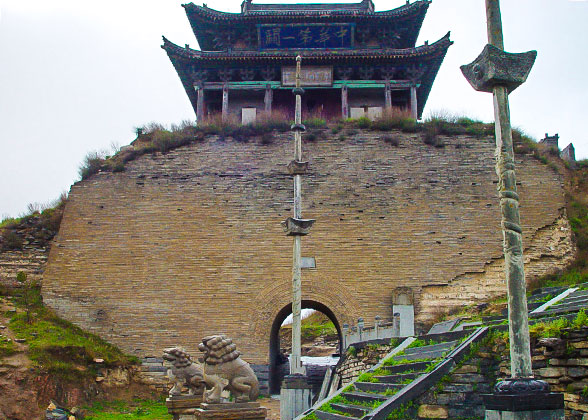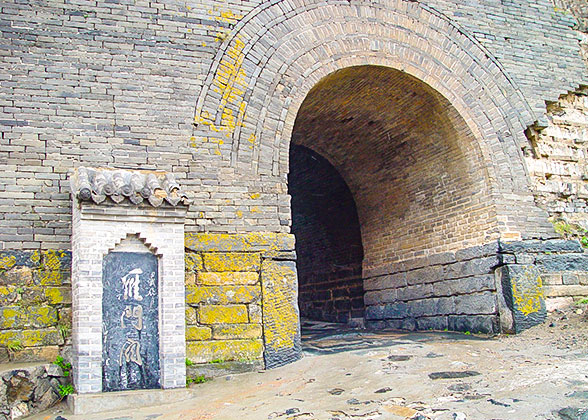Yanmenguan Great Wall
 |
| Yanmenguan Pass in Shanxi |
In the depths of Yanmen Mountain in Shanxi, there stands a lonely frontier outpost, Yanmenguan, some 2,000 years old. This once invincible patron saint along the boundary has cast off his armor and turns into an experienced old man waiting to tell you about his story.
Basic Facts of Yanmenguan Great Wall
![]() Yanmenguan Pass of Great Wall is 12 miles (19 kilometers) to the north of Daixian County, in Shanxi Province. It is one of the three passes of the Inner Great Wall. The Ningwu Pass and the Pianguan Pass are the others.
Yanmenguan Pass of Great Wall is 12 miles (19 kilometers) to the north of Daixian County, in Shanxi Province. It is one of the three passes of the Inner Great Wall. The Ningwu Pass and the Pianguan Pass are the others.
![]() In the Spring and Autumn Period (770 BC - 476 BC), King Wuling of Zhao State first established Yanmen County in this region. When Emperor Qin Shi Huang (259 – 210 BC) reigned over the country, he gave orders for the construction of Yanmen Pass to guard against the northern tribes. Since then, it has been bitterly contested.
In the Spring and Autumn Period (770 BC - 476 BC), King Wuling of Zhao State first established Yanmen County in this region. When Emperor Qin Shi Huang (259 – 210 BC) reigned over the country, he gave orders for the construction of Yanmen Pass to guard against the northern tribes. Since then, it has been bitterly contested.
![]() In Northern Song Dynasty (960 – 1127), the renowned warriors of the Yang family garrisoned it against invading Qidan troops from the northern prairie. These legendary warriors included female family members. You can find the statues of some of them lining along the entrance path of the scenic area.
In Northern Song Dynasty (960 – 1127), the renowned warriors of the Yang family garrisoned it against invading Qidan troops from the northern prairie. These legendary warriors included female family members. You can find the statues of some of them lining along the entrance path of the scenic area.
![]() The pass consists of a pass city, a barbican, and an enclosing wall. The pass city is located between two rolling hills, with a height of 30 feet (nine meters) and a perimeter of 1,100 miles (1,006 meters). The enclosing wall stretches outwards from the east and west wings of the pass city, measuring more than three miles (five kilometers) long, and it is dotted with beacon towers. The barbican was built outside the north gate of the pass city.
The pass consists of a pass city, a barbican, and an enclosing wall. The pass city is located between two rolling hills, with a height of 30 feet (nine meters) and a perimeter of 1,100 miles (1,006 meters). The enclosing wall stretches outwards from the east and west wings of the pass city, measuring more than three miles (five kilometers) long, and it is dotted with beacon towers. The barbican was built outside the north gate of the pass city.
 |
| Yanmenguan Pass Gate |
A Uniquely Designed Military Stronghold
![]() The northern gate is called Di Li Gate, with a barbican outside forming a double defense line. Unlike other barbicans, the entrance door was built on the east wall instead of the front to expose potential invaders on two sides.
The northern gate is called Di Li Gate, with a barbican outside forming a double defense line. Unlike other barbicans, the entrance door was built on the east wall instead of the front to expose potential invaders on two sides.
![]() Different from other passes, Tian Xi'an Gate, opening to the central plain, was not designed to face Di Li Gate directly. It was actually built at the northeast corner of the pass. The one right opposite the Di Li Gate was a false lead to the secluded area of the mountain. There was no walkable path behind, only thick trees, knee-height grass, and wild beasts waited ahead.
Different from other passes, Tian Xi'an Gate, opening to the central plain, was not designed to face Di Li Gate directly. It was actually built at the northeast corner of the pass. The one right opposite the Di Li Gate was a false lead to the secluded area of the mountain. There was no walkable path behind, only thick trees, knee-height grass, and wild beasts waited ahead.
![]() There is a large reservoir behind the Di Li Gate. It has military potentials. If Di Li Gate was broken through, defenders would wreck the dam to inundate enemies.
There is a large reservoir behind the Di Li Gate. It has military potentials. If Di Li Gate was broken through, defenders would wreck the dam to inundate enemies.
![]() A pagoda is on the northern slope on the enclosing wall, occupying the highest point of this whole area with an altitude of 5,968 feet (1,819 meters). It was an ideal command post. From there one can have a commanding view of the whole area.
A pagoda is on the northern slope on the enclosing wall, occupying the highest point of this whole area with an altitude of 5,968 feet (1,819 meters). It was an ideal command post. From there one can have a commanding view of the whole area.
Yanmenguan is now a popular tourism destination. Apart from military strategic use, you may spot landmarks as follows:
Zhenbian Hall
Outside Tian Xi'an Gate, it was intended to commemorate a distinguished General Li Mu of Zhao State (403 – 222 BC). But in 1856, a monk named Shan Quan had converted it into a duo purpose Buddhist shrine.
Temple of Guan Yu
At the west side of Di Li Gate, there is a temple dedicated to general Guan Yu, who hardly lost a battle in the Kingdom of Shu (221 – 263). Soldiers took Guan Yu to be the god of war and victory. Therefore, his temples flourished at Great Wall passes.
Yanmen Village
It is an old village at the foot of the pass. Residents have been there for generations. Their houses, lifestyle, and custom still preserve the traditional style, combining the features of the central plain and the northern nomads. By simply walking around, it gives you a profound sense of history. You may also sample the local cuisines here.
Frontier Trade Street
This flagstone walkway leads from Yanmen Village to the Di Li Gate, where the most prosperous frontier market operated in the Ming Dynasty (1368 - 1644) and Qing Dynasty (1644 – 1911). The grey-tiled residences showed how the old booming trading fair looked. You can find some interesting gadgets in the shops along the street.
Travel Tips
![]() The pass is 2,200 yards (2,012 meters) from the start of the scenic area. The one-way trip of sightseeing bus costs CNY 5.
The pass is 2,200 yards (2,012 meters) from the start of the scenic area. The one-way trip of sightseeing bus costs CNY 5.
![]() Located in the deep Yanmen Mountain, there won't be too many visitors whenever you come and the old fortress would entice you back into its time and place.
Located in the deep Yanmen Mountain, there won't be too many visitors whenever you come and the old fortress would entice you back into its time and place.
![]() The best time to visit the pass is May to June and September to October, when it is temperate weather. In May and June, the greenery energizes you. The scenes of September and October reflect different charm with fallen leaves coating the ground in yellow. Although winter (November to February) is cold, it does not matter much when the snow covers everything in white and you feel the solitude of this thousands-year-old fortress.
The best time to visit the pass is May to June and September to October, when it is temperate weather. In May and June, the greenery energizes you. The scenes of September and October reflect different charm with fallen leaves coating the ground in yellow. Although winter (November to February) is cold, it does not matter much when the snow covers everything in white and you feel the solitude of this thousands-year-old fortress.
| Admission Fee | April - October: CNY 90 November - March: CNY 60 |
|---|---|
| Opening Hours | 8:00 – 18:30 |
How to Get There From Datong
Yanmen Pass is 75 miles (120 kilometers) away from Datong City and 20 miles (32 kilometers) away from Daixian County. Take a coach from Datong Xinnan Passenger Station to Daixian County first. The coach departs from Datong at 7:20, 9:20, and 11:30 for a two hours trip. Upon arrival, take a taxi to the scenic area at a cost around CNY 100.
How to Get There From Taiyuan
Taiyuan is 110 miles (177 kilometers) away from the scenic area. Get to Daixian County first and take a taxi to the scenic area. The coaches bound for Daixian depart at Taiyuan East Passenger Station every 30 minutes from 7:45 to 18:30 and the trip lasts about 2.5-3 hours.